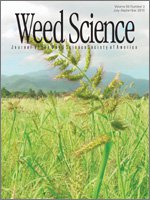Management practices and cropping systems that serve as integrated weed management practices, and at the same time can contribute to improved soil quality, will be important for the sustainability of agricultural production systems. The objective of this study was to assess weed species population density under contrasting tillage (conventional tillage [CT] and no tillage [NT]), residue burning (burn and no burn), and residue level (low and high) treatments after 5 and 6 yr of consistent management in a wheat–soybean double-crop production system. A field experiment was conducted from fall 2001 to fall 2007 in the Mississippi River Delta region of eastern Arkansas on a Calloway silt–loam. Weed assessments were conducted twice during the soybean growing season, before (early season) and after herbicide application (late season) in 2006 and 2007. Total weed density was greater under CT (513 plants m−2) than under NT (340 plants m−2) early in the growing season in 2006, but was greater under NT than CT late in the season in 2007, suggesting that the effectiveness of glyphosate on total weeds differs between CT and NT. Averaged across residue levels, grass species density was greatest in the NT–burn (68 to 167 plants m−2) combination and lowest in the NT–no-burn (41 to 63 plants m−2) early in the growing season in both years. Broadleaf density was greater early (200 to 349 plants m−2) than late (18 to 20 plants m−2) in the growing season under both CT and NT in 2006, but in 2007 broadleaf density did not differ by tillage treatment between seasons. Perennial weed density was greater in the burn (99 plants m−2) than in the no-burn (59 plants m−2) treatment in 2006. No tillage, no burning, and a high residue level appeared to contribute to the suppression of most weed species without reducing herbicide efficiency.
Nomenclature: Soybean, Glycine max Merr.; wheat, Triticum aestivum L.





